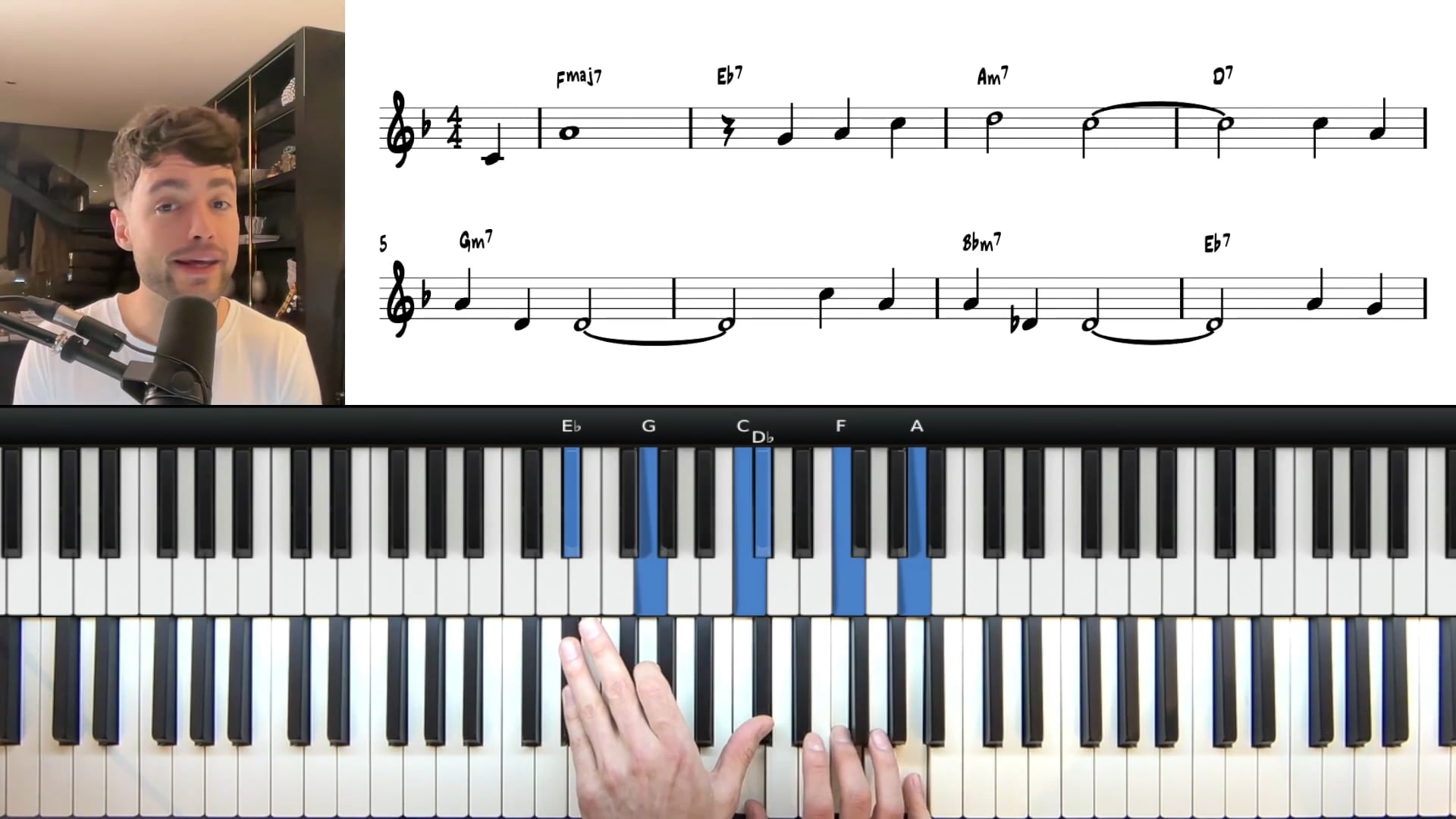
Hayden Hill
Hayden founded PianoGroove in 2015 with the goal of making the world a more musical place. He shares his love for jazz piano through his online courses and manages the community area of PianoGroove.
Live Seminar Resources
Live Seminar Resources
PDF Downloads
- Misty - Chord Chart
Join PianoGroove Pro to access all downloads and learning resources.
Download theory supplements, midi files, chord changes and full note-for-note transcriptions of every lesson.
- Tenderly - Chord Chart
Join PianoGroove Pro to access all downloads and learning resources.
Download theory supplements, midi files, chord changes and full note-for-note transcriptions of every lesson.
- Moonlight In Vermont - Chord Chart
Join PianoGroove Pro to access all downloads and learning resources.
Download theory supplements, midi files, chord changes and full note-for-note transcriptions of every lesson.
- Nearness Of You - Chord Chart
Join PianoGroove Pro to access all downloads and learning resources.
Download theory supplements, midi files, chord changes and full note-for-note transcriptions of every lesson.
- Georgia - Chord Chart
Join PianoGroove Pro to access all downloads and learning resources.
Download theory supplements, midi files, chord changes and full note-for-note transcriptions of every lesson.
- UST Cheat Sheet
Join PianoGroove Pro to access all downloads and learning resources.
Download theory supplements, midi files, chord changes and full note-for-note transcriptions of every lesson.
Related Lessons
Forum Threads
Seminar Description
Seminar Description
Tritone Substitution & Upper Structure Triads
Welcome to this advanced jazz piano lesson, where we explore the concepts of tritone substitution and upper structure triads. These techniques add harmonic depth and color to your playing, helping you create sophisticated jazz voicings.
In this lesson, we will break down the relationship between tritone substitution and upper structure triads, understand their theoretical foundations, and apply them to jazz standards. By the end, you’ll have a clear method to integrate these sounds into your own playing.
What is Tritone Substitution?
Tritone substitution is a common harmonic device in jazz where a dominant 7th chord is replaced by another dominant 7th chord a tritone (three whole steps) away.
For example, in an F major 2-5-1 progression:
- Gm7 → C7 → Fmaj7
We can substitute C7 with Gb7, creating a different harmonic movement: - Gm7 → Gb7 → Fmaj7
This works because C7 and Gb7 share the same tritone (E and Bb), meaning these chords can be interchanged to create move interesting chord progressions and unexpected harmonic movement and colors.
Applying Tritone Substitutions to Jazz Standards
We apply tritone substitutions to various jazz standards, such as:
- "Misty" (Replacing Eb7 with A7)
- "Georgia on My Mind" (Using tritone substitutions as passing chords)
- "You Don’t Know What Love Is" (Exploring minor 2-5-1 applications)
- "Tenderly" (Identifying when tritone substitutions do and don’t work)
Not all harmonic situations respond well to tritone substitution, and part of mastering this concept is gaining an appreciation for where it enhances or clashes with the harmony.
Upper Structure Triads: A Tool for Advanced Voicings
Upper structure triad (UST) voicings involve playing a triad in our right hand on top of a dominant 7th shell in our left hand, usually to access the altered tensions of the chord. These triads are commonly built on the 9th, sharp 11th, sharp 5th, or natural 13th as we have explored in the previous sessions. These USTs formulas are the most common and versatile voicings.
Example 1: C7 Upper Structure Triad
If we take C7 and build an Ab major triad on top, we get:
- C7 (root, 3rd, 7th) + Ab (Ab, C, Eb) → C7(#5, #9)
Example 2: Tritone Substitution & Upper Structures
When applying tritone substitution, the same upper structure triad can create a completely different color over the dominant chord a tritone away. An important relationship to understand is:
- C7(#5, #9) = G7(9, #11, 13)
- The Ab major triad over C7 gives us an altered #5#9 sound However, when we apply the same Ab major triad over Gb7, it creates a Lydian dominant sound and to be specific a natural 13-#11 sound.
This relationship allows us to use a familiar triad shape to create a completely different color and texture without needing to rethink the entire chord structure. We simply change the root note.
Practice Tips
- Drill Tritone Subs – Take any 2-5-1 progression and substitute the V7 chord with its tritone alternative.
- Memorize UST Formulas – Learn the common formulas which are major triad built on 9th, sharp 11th, sharp 5th, or natural 13th.
- Apply To Standards – Experiment with tritone substitutions in Misty, Georgia on My Mind, Tenderly, and any jazz standard you are working on to develop an ear for when they work best.
- Use In Improvisation – Outline upper structure triads in your right-hand soloing lines to create logically structured right hand melodies and to emphasize altered chord tones.
- Listen to Recordings – Study recordings of Bill Evans, Herbie Hancock, and McCoy Tyner to hear how advanced players use tritone substitutions and upper structure triads.
Mastering tritone substitution and upper structure triads unlocks a new world of harmonic possibilities, giving your playing a rich, modern jazz sound.
Keep practicing, experiment with different standards, and incorporate these techniques into your chord progressions and improvisations! 🎶








I loved the arrangement of ‘dream a lilttle dream ‘ Hayden. Loved it 👏
Great seminars 👏